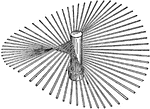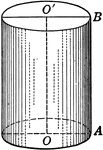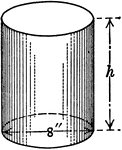
Torsion Balance
"ABCD is a cylinder of glass 1 foot in diameter and 1 foot high. This cylinder is closed by a glass…
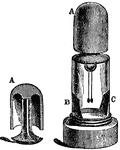
Cavallos Electroscope
"Cavallo's electroscope embodies the double pendulum principle. It consists of two fine silver wires…
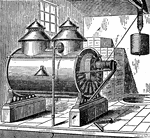
Auto-Pneumatic Apparatus
"Hearson's machine is cylindrical in form, and is surmounted by two turrets. Internally the cylinder…

Glass Cutter
"The cylinder is placed vertically in the jaws of a cutting instrument, having a diamond cutter, pressing…

Glass Cutter
"Now the splitting is done with a diamond cutter fixed in the fleft of a stick and guided from end to…

Glass Cutter
"In the arrangement of the flattening and annealing ovens numerous improvements have been effected,…

Gas Liquidation
"M. Cailleter's apparatus is represented. The gas under experiment is contained in a stout glass tube…

Gas Liquidation
"M. Cailleter's apparatus is represented. The gas under experiment is contained in a stout glass tube…

Pump
"The common pump consists of a hollow tube, the lower part of which, descending into the water, is called…

Forcing-Pump
"In the forcing-pump atmospheric pressure plays but a small part. There is no valve in the piston c,…

Chain-Pump
"The chain-pump consists of a tube or cylinder, the lower part of which is immersed in a well or reservoir,…
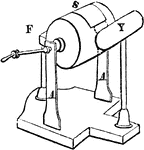
Electrical Machine
"A form of an electrical machine. S being the glass cylinder turning on an axis, Y the conductor, F…

Magnetic Telegraph
"Morse magnetic telegraph will be understood by reference to the accompanying diagram, which represents…
Egyptian Charm
"A small porcelain cylinder ornamented with interlaced lotus flowers in intaglio, having a ring for…

Lace Machine
"A section of part of a lace machine. E is the cylinder or beam upon which the lace is rolled as made,…

Striking Machine
"Striking machines are now very generally used for the operation. These consist of a drum or cylinder…
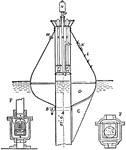
Automatic Buoy
"Courtney's Automatic Buoy. A, cylinder, 27 ft. 6 in. long; B, mooring shackle; C, rudder; D, buoy;…
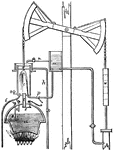
Newcomens Engine
"The simple outline of the atmospheric engine. Its mode of operation is as follows. Steam is admitted…

Double-acting Cylinder
"The first alteration to be noticed in the double-acting engine is that of the cylinder. To insure its…

Double-acting Cylinder
"The first alteration to be noticed in the double-acting engine is that of the cylinder. To insure its…

Oxy-calcium Lamp
"A small cylinder of lime is heated to intense luminosity in the flame of a spirit lamp through which…

Regnaults Manometer
"AB is a strong metal tube, closed at the lower end, and carrying at the upper a bent pipe for admitting…
Compressed Air Manometer
"The compressed air manometer consists of a strong graduated glass tube of uniform narrow bore, closed…

Micrometer
"The original Merz micrometer of the Cape Observatory, made on Fraunhofer's model. S is the head of…
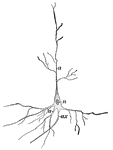
Nerve Cell
Nerve cell from the brain; a, processes by which it communicates with other cells near by;…
Army-Worm Killer
It consists of a sheet-iron furnace, having the form of a half cylinder, tapered at the end's, in which…

Archime' dean Screw
A cylinder with a triple threaded screw in a water tight case that revolves ater to the top for the…
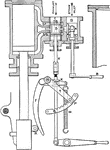
Valve gear of a steam hammer
"The valve gear for operating the steam hammer is shown separately, the cylinder and valve chest being…
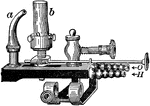
Lime-Light Burner
a is the burner tip for an oxy-hydrogen flame, and b is the cylinder of quicklime.

Induced Charge
"Experiment illustrating the nature of an induced charge. The apparatus consists of a metal ball and…

Lines of Force under Induction
"Lines of force of a charged sphere and a conductor under induction. The negative electrification on…
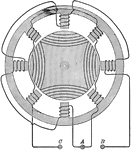
Altenating Current Motor
"...consists of a circular, multipolar field magnet, inclusing a cylinder armature with coils wound…
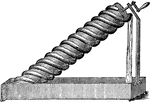
Archimedes' Water Screw
"It consists of a tube, made of lead, or strong leather, coiled round a cylinder of wood or iron, as…
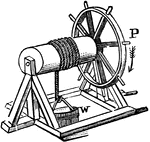
Wheel and Axle with Rope and Bucket
"The wheel and axle consists of a wheel united to a cylinder in such a way that they may turn together…

Screw press
"A screw is a cylinder, generally made of wood or metal, with a spiral ridge (the thread) winding about…
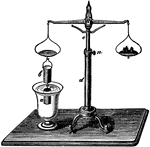
Archimedies Principle
"From one end of a scale-beam, suspend a cylindrical metal bucket, b, with a solid cylinder, a, that…

Nicholson Hydrometer
"The Nicholson hydrometer of constant volume is a hollow cylinder carrying at its lower end a basket,…
!["The graphic method of studying sounds, which fairly meets even the exacting demands of physicists, and is largely used by them may be briefly explained thus: Suppose the smoked plate [shown] to be a sheet of smoked paper fastened around a cylinder that is mounted that, when it is turned by a crank, the screw cut upon the axis moves the cylinder endwise as shown. Such and instrument is called a vibroscope." -Avery 1895](https://etc.usf.edu/clipart/35900/35992/vibroscope_35992_mth.gif)
Graphic Method of Studying Sounds Using a Vibroscope
"The graphic method of studying sounds, which fairly meets even the exacting demands of physicists,…
!["One of the best-known instruments of this [electrometer] class is Coulomb's torsion-balance, which consists essentially of gilt ball, i, carried at the end of a horizontal shellac needle that is suspended by a fine silver wire from the top of a tube that rises from the cover of the enclosing glass cylinder. A vertical insulating rod passing through the cover carries a handle, a, and a gilt ball, e, at its ends." -Avery 1895](https://etc.usf.edu/clipart/36000/36071/torsion_bal_36071_mth.gif)
Coulomb's Torsion-Balance
"One of the best-known instruments of this [electrometer] class is Coulomb's torsion-balance, which…
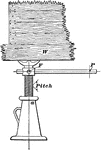
Using a Screw to Raise Weight
"A screw is a cylinder with a helical proection winding around its circumference. This helix is called…

Water versus Wood Pressure
"The vessel a is fitted with a wooden bock of the same size as, and free to move in, the cylinder; the…

Archimedes Principle
"From on pan suspend a hollow cylinder of metal t, and below that a solid cylinder a of the same size…
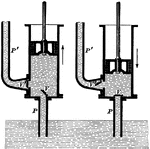
Forcing Pump
"As the piston ascends, as shown in the left-hand figure, the pressure of the atmosphere forces the…
!["A double-acting pump of the piston pattern is shown [here]. Such a pump has two sets of suction valves and delivery valves, one set for each side of the piston. With the piston moving in the direction of the arrow, the pressure of the atmosphere forces the water up the suction pipe P into the left-hand end of the pump cylinder, the left-hand suction valve opens and the left-hand delivery valve is closed...The water now flows up the delivery pipe P'." —Hallock 1905](https://etc.usf.edu/clipart/36100/36170/2act_fpump_36170_mth.gif)
Double-acting Force Pump
"A double-acting pump of the piston pattern is shown [here]. Such a pump has two sets of suction valves…
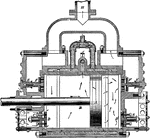
Air Compressor
"For many purposes compressed air is preferable to steam or other gas for use as a motive power. In…

Compressibility of Air
"Let P be a piston, fitted, air-tight, to the cylinder AB. As the piston is driven down, the air, unable…
Screw
"Cylinder with a spiral of winding parallel ridges called Threads. If the Threads were unwound from…
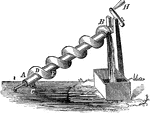
Archimedes' Screw
"Invented to raise water. A hollow tube wound spirally around a solid cylinder. As the cylinder is turned,…

Cylinder Inscribed in Pentagonal Prism
Right circular cylinder inscribed in a pentagonal prism. Or, Pentagonal prism circumscribed about a…
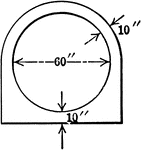
Cross Section of Concrete Conduit
Cross section of concrete conduit. The diagram can be used to find volume.
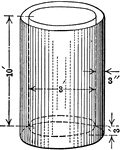
Cylindrical Water Tank
Cylindrical water tank with a height of 10 ft., thickness of 3 inches, and diameter of 3 feet. The diagram…
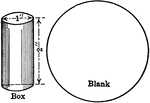
Cylindrical Box - Blank
Sheet metal blank for making a cylindrical box with a diameter of 1 inch and a height of 2 inches.
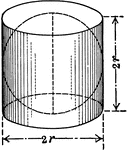
Sphere Inside of Cylinder.
An illustration of a sphere inside of a cylinder with radius/diameter labeled. Illustration for showing…
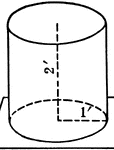
Right Circular Cylinder With 1 ft. Radius and 2 ft. height.
Right circular cylinder with a radius of 1 foot and a height/altitude of 2 feet.


